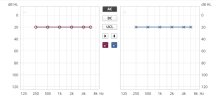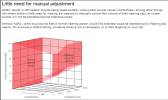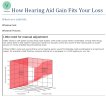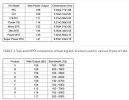mthomas
New Member
- Joined
- Oct 5, 2023
- Messages
- 3
- Reaction score
- 0
Hello Everyone,
I am on a quest to comprehend the functionalities of hearing aids and their fitting software. We all know their primary purpose is to improve our hearing, but I'm eager to understand the mechanics behind it. For instance, in my right ear, I need a 8000 Hz tone to be amplified to 95db before I can acknowledge it in an audiology test.
Naturally, on my Audiogram, there's an X mark at 95 on the 8000 axis. Now, when it comes to the hearing aid, does it mean we need it to boost that particular frequency gain by 95db? Similarly, if it takes 40db for me to hear a 1000 Hz tone, does the hearing aid amplify that frequency gain by 40db?
I pose these questions because I'm curious about the audiologist's method during a hearing aid fitting. Are they adjusting the gain for each frequency according to that loss to enable you to hear? While I acknowledge the complexity of audiology and respect that professionals spend years mastering it, personal circumstances make access to an audiologist difficult for me. Thus, I aim to program my own hearing aid. However, I want to have a clear understanding of what I'm instructing the fitting software to do, instead of making arbitrary adjustments.
Can anyone shed light on this process, or share the key objective here? I am eager to grasp this concept rather than rely on trial and error adjustments.
Much Appreciated.
M
I am on a quest to comprehend the functionalities of hearing aids and their fitting software. We all know their primary purpose is to improve our hearing, but I'm eager to understand the mechanics behind it. For instance, in my right ear, I need a 8000 Hz tone to be amplified to 95db before I can acknowledge it in an audiology test.
Naturally, on my Audiogram, there's an X mark at 95 on the 8000 axis. Now, when it comes to the hearing aid, does it mean we need it to boost that particular frequency gain by 95db? Similarly, if it takes 40db for me to hear a 1000 Hz tone, does the hearing aid amplify that frequency gain by 40db?
I pose these questions because I'm curious about the audiologist's method during a hearing aid fitting. Are they adjusting the gain for each frequency according to that loss to enable you to hear? While I acknowledge the complexity of audiology and respect that professionals spend years mastering it, personal circumstances make access to an audiologist difficult for me. Thus, I aim to program my own hearing aid. However, I want to have a clear understanding of what I'm instructing the fitting software to do, instead of making arbitrary adjustments.
Can anyone shed light on this process, or share the key objective here? I am eager to grasp this concept rather than rely on trial and error adjustments.
Much Appreciated.
M














